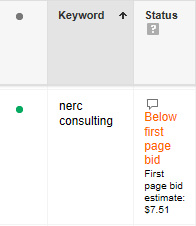3 Lessons Learned from PPC Advertisers in the B2B Software Industry

Are you working in a niche B2B industry attempting to generate leads (that hopefully convert) through your PPC efforts? In that case, I can assume that you are also on the verge of throwing a baseball at your computer. Am I right? PPC is challenging enough, but with the added long sales cycle, high competition, and niche market, getting leads from AdWords can make your sanity spin off the deep-end.
All too often I find this to be true with clients specifically in the software or SaaS industry. Gaining leads is a challenge in itself and definitely does not mean that a conversion is likely to follow. For example, searchers looking to purchase software don’t just hop online, search for their business need, and hit “Buy Now.” Software services typically a) are expensive and b) have longer sales cycles.

Purchasing a software solution can come with many challenges, including:
- Comparison shopping: Your target buyers are comparing you to at least three or four of your top competitors.
- Financial commitment: Software services are typically expensive and require extensive research and often free trials before taking the plunge.
- Approval: Typically several internal parties will need to approve the investment. Will this software add value to the business? Will the investment be justified by the return? Is the price range within our department budget? These difficult questions will need to be answered before decisions can be made and finalized.
In order to get an even more thorough understanding of how to address the challenges PPC managers are facing in the software industry, I spoke with three WordStream customers from various backgrounds who are currently running AdWords campaigns for software companies. Many of their challenges and the solutions to these challenges overlapped, but I learned three valuable lessons that I’d like to pass on to you folks who are on the verge of permanently deleting your AdWords account.
Managing PPC Campaigns for Software Companies: 3 Lessons from the Trenches
Robert Withers is the Director of Marketing at SecureAuth, which provides a software solution to help turn any enterprise into an identity provider able to enforce 2-Factor Access Control. What does that mean? I’m not exactly sure, and as Withers said, “this isn’t a simple software” – in other words, his target audience is niche and often looking for high-level information.
Before joining the marketing team at SecureAuth, Withers did PPC in a variety of industries ranging from entertainment to consumer packaged goods. “With the other industries I’ve worked in, the offer was simple, like ‘buy this product’ or ‘give us a call,’ but this is a B2B sell and these products are research-heavy,” Withers said. “Conversions are tough – you’ve got be at the right place at the right time.” Here are a few tips to take away from Withers:
Lesson #1: Know your audience and cater to where they are in the buying cycle.
“The reason your PPC campaign isn’t working is you tried to kiss your customer on the first date,” explains CEO of Nerds Do It Better, Adam Lundquist. I love this analogy because it is often true, and advertisers don’t realize until they test.
This is exactly what Withers did. In the past, SecureAuth’s Google ads led visitors to a landing page offering a free 30-day trial. This seemed brilliant at the time –until Withers noticed he was getting clicks, but visitors had commitment phobia and were quickly turned off by such an aggressive offer. “That’s going too far, too fast, so we peeled back, instead offering a live demo. This small tweak doubled our conversion rate,” Withers said.
With this lesson in mind take action by:
- Creating a realistic call-to-action within your ad text: If you’re unsure of which call-to-action might work best, rotate your ads to do some A/B testing, but be certain you have enough data before choosing one CTA over another.
- Perfecting your landing page experience: Withers finds the landing page experience to be the most important factor in gaining leads, especially in an industry where consumers are also going to be visiting competitor sites before making a decision. You need to give the searcher information for where they are in the buying cycle. “If they’re on Google they’re just getting started, which means we need to ensure the information on the landing page is at the tip of the sales cycle,” Withers states.
Lesson #2: Continuously improve your keyword strategy; trial and error is key!
Let’s rewind a bit to keyword strategy. Targeting the right keywords is challenging in any industry, but with B2B and software specifically, where the product is very niche and tightly focused, it can provide a whole new set of challenges. I often hear PPC managers in niche industries insisting on “long-tail keyword strategies,” but the issue is instead of driving relevant clicks these very long-tail keywords typically have such low traction that they end up just rotting away with 0 clicks and limited impressions. Conversely if keywords are too broad, it is easy to waste a huge chunk of your budget on an irrelevant demographic. Unfortunately with Google search there is no magical setting to serve up your ads to just your target audience, so constantly refining your keyword strategy is essential to finding your niche.
Marketing Specialist Leah Morse at SigmaFlow, a software solution for process execution (specifically for NERC CIP & 693 compliance and oil & gas well delivery), found keyword strategy to be one of the biggest challenges with AdWords. “Finding the right words to bring the right people to your site is a huge challenge,” Morse told me. “We’ve made progress, but it’s been a lot of trial and error.” Don’t be afraid to fail!
The keywords are the starting point to exposing your brand and familiarizing potential buyers with your products, so finding keywords that work and maintaining your list of keywords in your ad groups is essential. Here are a few things to do ASAP:

- Pause or delete any “Low Search Volume” keywords and increase the bids of keywords under the first page bid estimate. Google makes this pretty easy since next to the keywords tab there’s a status that identifies these keywords (see image above).
- Bid on the keywords that people are searching for rather than product-specific keyword that have limited traction. Leah uses WordStream’s QueryStream tool to determine what people are typing into Google to make her ads appear, and then adjusts her strategy accordingly. For example, Leah noticed that the keyword “NERC ROI Calculator” had 0 hits, but “NERC Consulting” was knocking it out of the park so she adjusted her strategy to have a consulting ad group with a higher budget rather than bidding on keywords without search potential.
- Don’t rule out high-impression, low click-through keywords. As Leah said, “Part of it is just brand awareness. As a newer solution we like getting our name out there.” As you know the sales cycle for software solutions can be slower than an overweight turtle crossing an inclined gravel road so impressions = exposure and exposure = trust (which over time can lead to sales). Of course if these high-impression, low-conversion keywords are costing you a heavy penny then it might be smart to use caution. Another recommendation is using the display network to expose your brand across the web – just make sure you’re targeting relevant sites so your budget isn’t wasted on an irrelevant audience.
Lesson #3: Stand out from your competitors by creating a PPC experience that comes full-circle.
Digital Marketing Specialist Ben Brooks has been using AdWords since 2005, working with clients in industries ranging from construction to healthcare. Brooks currently executes the PPC efforts for Nintex, the world’s largest workflow platform. Even though Nintex has a well-established brand, Brooks finds competition to be a challenge.
“Nowadays the process of developing your own software and putting it out there is simple, so there’s a lot more competition,” Brooks said. “It’s so easy for someone to switch over to a competitor’s product, which is why we have to be even more careful when crafting the message from keywords, to ads, to landing page, to offer.”
Yes, we all know the importance of relevancy when it comes to PPC. Having your keywords reflected in your ad text and then tying directly to your landing page is critical to avoid bounced clicks, but when all your competitors have this down pat, what else can be done?
- Craft ad text that highlights your software’s strengths. “There’s 12 ads, but why is ours the best?” states Brooks. “Then send them to a landing page that confirms that message.” Figure out what sets your company apart from your competitors and utilize that to your benefit. “Make sure your copy speaks to the buyer’s pain points in a clear, compelling way,” writes internet marketing consultant Brad McMillen. Your ad copy should also pre-qualify customers by mentioning price points and special offers – this will help weed out searchers not in your price range and entice those looking to take advantage of a limited-time discount.
- Stay on-top of Google updates & utilize them to your benefit. Brooks already uses sitelink extensions, but when he heard about the new callout extensions he knew the opportunity was too good to ignore. Callout extensions are essentially sitelink extensions without the link, but the main benefit is being able to add more text to your ad so searches have more information regarding unique selling points before clicking. These new extensions also play a factor in increasing your ad rank.

- Use data to better focus your budget. “Another issue with AdWords is the amount of money we can spend exceeds the money we have to spend,” says Brooks. “Of the five products we’re advertising I’ll investigate which one is giving us the most bang for our buck and focus more of our budget there.” Another quick win is using the dimensions tab to find out which days of the week and hours of the day are resulting in the best ROI or lowest CPA’s. A recent WordStream study found that B2B companies (unshockingly) perform best Monday through Friday during business hours. If that’s also the case for your business then excluding lower performing hours with ad scheduling can significantly improve results by serving up your ads more often when it counts.

So put that baseball down, take a deep breath, and move your mouse away from the “delete my entire AdWords account” button. B2B software companies can succeed and grow their business with PPC advertising without breaking their computer or the bank.
Fellow B2B advertisers, what strategies work for you when it comes to PPC?
How have you addressed the challenges of a longer sales cycle and high-competition industry?
How do you best target the niche audience looking to (eventually) buy?









